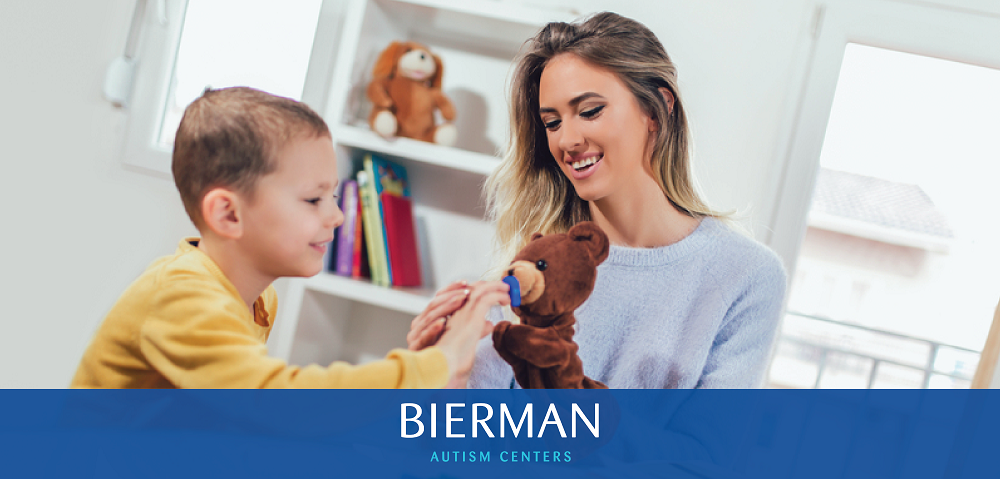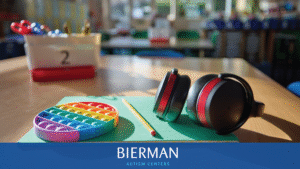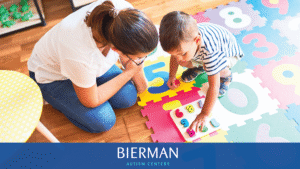Developmental Milestones for speech and language vary by age. A child’s communication skills begin to emerge through development of prelinguistic skills. These skills include joint attention, gross motor imitation skills, and play skills. Joint attention skills include the ability to look between the communication partner and something else. For example, if you and your child are walking through the zoo and you point at the lion off to the side, will your child also look that way?
Gross motor imitation skills can be achieved with both objects and movements. Example, if you shake the rattle and give it to your child, will they attempt to shake it? If you clap your hands, will your child clap their hands? If you blow bubbles, will your child attempt to pop them?
Play skills are an important area of language development because it shows that your child is able to engage with another person. For example, does your child enjoy pretend playing with farm animals? Does your child make a car go down the ramp or make pretend food out of play-doh? All of these skills are important to look at prior to a child beginning to express themselves with verbal communication.
Once these skills start to emerge, ideally, you will start to recognize more receptive and expressive language from your child and you might hear them say their first word.
The following indicates different milestones for certain ages. It should be noted that this list is not exhaustive.
By ages 2 to 3, expressive language skills can include producing vowels and early developing consonant sounds (p, b, m, n, h, w, and d) correctly in words. Your child’s speech will start to become more clear, however, it might not be 100% intelligible to all communication partners. By this age, we typically see children start to answer simple questions such as, “what do you do when you are hungry?”. Additionally, children begin to use some plurals in words, and start using regular past tense verbs such as “walked, jumped, played” etc.
Between the ages of 3 to 4, children begin to become more intelligible and are understood by the majority of their communication partners. They are able to produce later developing consonant sounds (t, k, g, f, and y), and produce every syllable of words. Additionally, children begin to tell stories during this time. You might see this during play as the child works to tell you about what they are doing.
By the time a child is 5, a child’s grammar becomes more clear, intelligible, and longer sentences are understood. Sentences they produce become more complex with vocabulary. Receptively, children start to follow directions when playing games with caregivers and peers. Children’s social skills begin to develop and become more natural when engaging with peers.
If you are looking for further information on milestones, contact your child’s pediatrician, a licensed speech therapist or visit the American Speech-Language-Hearing Association website at asha.org
At what age should a child start speech therapy?
The fact of the matter is, every child is different. Recognizing what communication skills your child is showing and what skills they aren’t is important. Seeking professional and clinical support from a pediatric speech therapist sooner will provide the family and the child with many resources. Trust your gut, if you have concerns, reach out to your doctor or a licensed speech language pathologist near you. This will provide guidance towards the next steps needed in knowing whether speech therapy services are warranted.
When should I be concerned about my child’s speech?
You know your child the best. If you feel concerned about their speech development, communication skills, and language development, reach out to a skilled professional who can help assist you. Speech Language Pathologists are trained in language development as well as speech sound production and have a clear understanding of early language milestones that children typically meet at different stages of development. If you, your family, or anyone who closely interacts with your child is having a difficult time understanding what they are trying to communicate, this could be an indication that seeking a professional opinion from a speech language pathologist could be beneficial for both your child and family.
What is the Importance of Early Intervention?
Early intervention can expose the child to a variety of skills needed to communicate. These include things such as joint attention and gross motor imitation skills. In addition, the speech pathologist is able to demonstrate different play skills and build upon the skills your child already has to help create a child-led environment that is rich in confidence and language. Early intervention speech therapy provides a child with consistent models of play and language skills that are necessary for the development of functional communication. By prioritizing early intervention speech therapy services for your child, you can become more equipped to help meet the individual needs related to their communication skills.
What are the Benefits of Speech Therapy for Children with Autism?
As speech therapists, we work to provide children with varying diagnoses such as Autism, a means of communication. This can look different to all children, some might express themselves with verbal communication and others through utilizing Augmentative and Alternative Communication, or AAC, modalities. Augmentative and Alternative Communication can include but is not limited to, sign language, gestures, and speech generating devices. It is within our scope of practice to find a consistent, robust, and reliable method of communication that will help your child express their wants and needs as well as build relationships with others to communicate in a functional manner.
In pediatric speech therapy, the speech therapist’s goal is to help facilitate language expanding activities in order for the child to feel confident and capable of using the skills they have gathered in speech therapy to communicate their wants, needs, and advocate for themselves in all environments with whomever they choose to communicate with.
While your child might have a primary diagnosis of Autism, a secondary diagnosis may be present. It is the job of the speech pathologist to understand how this secondary diagnosis may be impacting your child’s ability to communicate effectively. Examples of other diagnoses can include Childhood Apraxia of Speech, articulation and phonology disorders, fluency disorders previously referred to as stuttering, and pragmatic disorders. The benefit of speech therapy for a child with Autism includes the speech therapist’s ability to diagnose and treat communication disorders.
What are some Practical Tips and Strategies for Home Support?
- Read with your child at home. This does not have to be a lengthy endeavor; however, it could occur every night for a few minutes. Reading the same story every night can become taxing. Instead, try making up your own story with the pictures, better yet, just talk about the pictures! There is a reading approach called dialogic reading which focuses on your child’s engagement throughout the story. When employing the dialogic reading approach, you work to ask your child questions about what is happening in the story, to point to a letter on the page, help you turn the page, etc. When your child is engaged in the story, this allows for you as the parents to take the back seat and let the child lead. You can expand on the child’s responses and therefore, provide them with more language exposure.
- Narrate your life! When making dinner, describe what you are doing as you do it. “I am chopping the carrots. Cut, cut, cut. Now, I am putting them into the hot water. Be careful!’ Your child might even become interested in what you are doing and want to help, thus creating a fun family activity. Another example could include when you are driving in the car, you can talk about the trees being green, the red light means stop, and that you are going slow/ fast. By doing this, you are providing language exposure to your child and modeling different contexts in which certain words are used. This can help to alleviate pressure from the child from having to think of something to say.
- Don’t ask too many questions and when you do, provide options for your child. Example, you pick up your child from school and start asking them “how was your day?, what did you learn?, what did you eat?, who did you play with”. Odds are your child many things they want to share with you about their day. However, they might not have the language available or it might be feeling overwhelmed by all of the questions being asked. Instead, you could say something such as “did you play with Jimmy or Johnny today?”. This will allow your child the opportunity to focus on one topic at a time while also connecting with their communication partner.
- Exposure to language! Language opportunities are everywhere. While your child might not understand what you are saying exactly, providing them with the language and the general setting of when/ where a word/phrase is used can help them.
Conclusion: Does My Child Need Speech Therapy?
If you have read through this blog post and you are thinking, ‘my child does everything the milestones say’, then great! Keep in mind that the area of speech language pathology looks at a wide variety of skills and diagnoses. These include but are not limited to articulation and phonology disorders, expressive and receptive language disorders, motor speech disorders, fluency disorders, pragmatic skills, voice disorders, cognition, auditory processing, etc. Seeking the assistance from a skilled speech therapist would provide you with information on the areas where your child may need intervention.
If you are thinking that your child may benefit from speech therapy services, do not fret. I know it may be scary and you may be thinking that your child is behind in development, but remember all children develop at their own pace. If you are ready to take that next step and seek speech services, here is what you should do!
Schedule an appointment with your pediatrician to rule out any other potential underlying causes of speech and language delays and/or disorders.
Receive a referral to a speech language pathologist who will provide your child with a language evaluation.
Schedule an evaluation through a provider to begin treatment with a licensed speech therapist.


